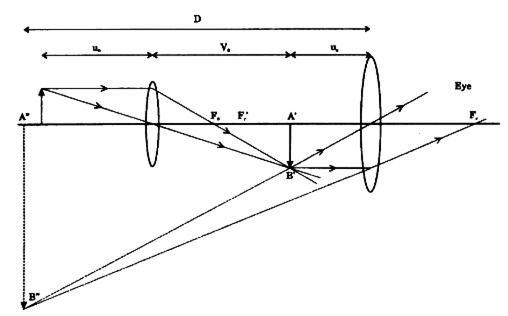In an astronomical telescope of refracting type :
Eyepiece has greater focal length.
Objective has greater focal length.
Objective and eyepiece have equal focal length.
Objective and eyepiece have equal focal length.
B.
Objective has greater focal length.
a) A convex lens of focal length 5 cm is used as a simple microscope. Where should an object be placed so that the image formed by it lies at the least distance of distinct vision (D = 25 cm)?
b) Draw a labelled diagram showing the formation of an image by a refracting telescope when the final image lies t infinity.
Given,
Focal length, f = 5 cm
Image distance, v = D = 25 cm
Object distance, u =?
Using the formula,
b) Reflecting telescope (final image at infinity) is as shown below:
Derive the formula for angular magnification of a compound microscope, when the final image is formed at least distance of distinct vision. Draw the required ray diagram.
The angular magnification of a compound microscope is the ratio of the angle subtended by the final image at the eye to the angle subtended by the object at the eye, when both are placed at the least distance of distinct vision.


This is the required expression for angular magnification.
Draw a labelled diagram of an image formed by a compound microscope, with the image at least distance of distinct vision. Write any one expression for its magnifying power.
Image formed by a compound microscope:

(i) Define Resolving Power of a simple astronomical telescope.
(ii) State one advantage of a reflecting telescope over refracting telescope.
(i) Resolving power of a telescope is its ability to see two very closely objects just separate
(ii) Advantage of reflecting telescope over refracting telescope is, there is no loss of light in case of reflection, image produced by a reflecting telescope is much brighter than that produced by a refracting telescope.
